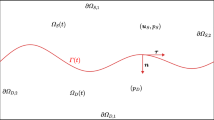Abstract
A coupled intravascular–transvascular–interstitial fluid flow model is developed to study the distributions of blood flow and interstitial fluid pressure in solid tumor microcirculation based on a tumor-induced microvascular network. This is generated from a 2D nine-point discrete mathematical model of tumor angiogenesis and contains two parent vessels. Blood flow through the microvascular network and interstitial fluid flow in tumor tissues are performed by the extended Poiseuille’s law and Darcy’s law, respectively, transvascular flow is described by Starling’s law; effects of the vascular permeability and the interstitial hydraulic conductivity are also considered. The simulation results predict the heterogeneous blood supply, interstitial hypertension and low convection on the inside of the tumor, which are consistent with physiological observed facts. These results may provide beneficial information for anti-angiogenesis treatment of tumor and further clinical research.
Similar content being viewed by others
References
Baish J.W., Gazit Y., Berk D.A., Nozue M., Baxter L.T. and Jain R.K. (1996). Role of tumor vascular architecture in nutrient and drug delivery: an invasion percolation-based network model. Microvascular Res. 51: 327–346
Jain R.K. (2001). Delivery of molecular and cellular medicine to solid tumors. Adv. Drug Delivery Rev. 46: 149–168
Stokes C.L. and Lauffenburger D.A. (1991). Analysis of the roles of microvessel endothelial cell random motility and chemotaxis in angiogenesis. J. Theor. Biol. 152: 377–403
Anderson A.R.A and Chaplain M.A.J. (1998). A mathematical model for capillary network formation in the absence of endothelial cell proliferation. Appl. Math. Lett. 11: 109–114
Anderson A.R.A and Chaplain M.A.J. (1998). Continuous and discrete mathematical models of tumor-induced angiogenesis. Bull. Math. Biol. 60: 857–900
McDougall S.R., Anderson A.R.A, Chaplain M.A.J. and Sherratt J.A. (2002). Mathematical modeling of flow through vascular network: implications for tumor-induced angiogenesis and chemotherapy strategies. Bull. Math. Biol. 64: 673–702
Stephanou A., McDougall S.R., Anderson A.R.A. and Chaplain M.A.J. (2005). Mathematical modelling of flow in 2D and 3D vascular networks: applications to anti-angiogenic and chemotherapeutic drug strategies. Math. Comp. Model 41: 1137–1156
Stephanou A., McDougall S.R., Anderson A.R.A. and Chaplain M.A.J. (2006). Mathematical modelling of the influence of blood rheological properties upon adaptative tumour-induced angiogenesis. Math. Comp. Model 44: 96–123
Zheng X., Wise S.M. and Cristini V. (2005). Nonlinear simulation of tumor necrosis, neo-vascularization and tissue invasion via an adaptive finite-element/level-set method. Bull. Math. Biol. 67: 211–259
Wu J., Xu S.X., Zhao G.P., Collins M.W., Jiang Y.P. and Wang J. (2006). 3D numerical simulation of hemodynamics in solid tumor (in Chinese). J. Med. Biomech. 21: 8–13
Gao H., Xu S.X., Cai Y. and Collins M.W. (2006). Numerical simulation of tumor-induced angiogenesis in and out of tumor incorporating mechanical effects (in Chinese). J. Med. Biomech. 21: 1–7
Kuszyk B.S., Corl F.M., Franano F.N., Bluemke D.A., Hofmann L.V., Fortman B.J. and Fishman E.K. (2001). Tumor transport physiology: Implications for imaging and imaging-guided therapy. Am. J. of Radiol. 177: 747–753
Netti P.A., Baxter L.T., Boucher Y., Skalak R. and Jain R.K. (1997). Macro- and microscopic fluid transport in living tissues: Application to solid tumors. AICHE J. 43: 817–834
Netti P.A., Roberge S., Boucher Y., Baxter L.T. and Jain R.K. (1996). Effect of transvascular fluid exchange on pressure–flow relationship in tumors: a proposed mechanism for tumor blood flow heterogeneity. Microvascular Res. 52: 27–46
Baxter L.T. and Jain R.K. (1989). Transport of fluid and macromolecules in tumors I. Role of interstitial pressure and convection. Microvascular Res. 37: 77–104
Author information
Authors and Affiliations
Corresponding author
Additional information
The project supported by the National Natural Science Foundation of China (10372026).
Rights and permissions
About this article
Cite this article
Zhao, G., Wu, J., Xu, S. et al. Numerical simulation of blood flow and interstitial fluid pressure in solid tumor microcirculation based on tumor-induced angiogenesis. Acta Mech Sin 23, 477–483 (2007). https://doi.org/10.1007/s10409-007-0098-x
Received:
Revised:
Accepted:
Published:
Issue Date:
DOI: https://doi.org/10.1007/s10409-007-0098-x




